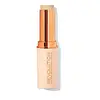Revolution Beauty Fast Base Stick Foundation Versus Maybelline Shine-Free + Balance Stick Foundation
What's inside
What's inside
 Key Ingredients
Key Ingredients

 Benefits
Benefits

 Concerns
Concerns

 Ingredients Side-by-side
Ingredients Side-by-side

Ethylhexyl Palmitate
EmollientMethyl Methacrylate Crosspolymer
Hydrogenated Polyisobutene
EmollientPolyethylene
AbrasivePhenyl Trimethicone
Skin ConditioningNylon-12
Diisostearyl Malate
EmollientOzokerite
Emulsion StabilisingPolyvinyl Laurate
Disteardimonium Hectorite
StabilisingCaprylyl Glycol
EmollientPropylene Carbonate
SolventCI 77220
Cosmetic ColorantZinc PCA
HumectantAcrylonitrile/Methyl Methacrylate/Vinylidene Chloride Copolymer
CI 77891
Cosmetic ColorantCI 77491
Cosmetic ColorantCI 77492
Cosmetic ColorantCI 77499
Cosmetic ColorantMica
Cosmetic ColorantFish Oil
Skin ConditioningIsononyl Isononanoate
EmollientDimethicone
EmollientCera Microcristallina
Emulsion StabilisingSilica
AbrasiveCopernicia Cerifera Cera
EmollientVinyl Dimethicone/Methicone Silsesquioxane Crosspolymer
Dimethicone Crosspolymer
Emulsion StabilisingTocopheryl Acetate
AntioxidantLauryl Methacrylate/Glycol Dimethacrylate Crosspolymer
Ethylhexyl Palmitate, Methyl Methacrylate Crosspolymer, Hydrogenated Polyisobutene, Polyethylene, Phenyl Trimethicone, Nylon-12, Diisostearyl Malate, Ozokerite, Polyvinyl Laurate, Disteardimonium Hectorite, Caprylyl Glycol, Propylene Carbonate, CI 77220, Zinc PCA, Acrylonitrile/Methyl Methacrylate/Vinylidene Chloride Copolymer, CI 77891, CI 77491, CI 77492, CI 77499, Mica, Fish Oil, Isononyl Isononanoate, Dimethicone, Cera Microcristallina, Silica, Copernicia Cerifera Cera, Vinyl Dimethicone/Methicone Silsesquioxane Crosspolymer, Dimethicone Crosspolymer, Tocopheryl Acetate, Lauryl Methacrylate/Glycol Dimethacrylate Crosspolymer
 Reviews
Reviews

Ingredients Explained
These ingredients are found in both products.
Ingredients higher up in an ingredient list are typically present in a larger amount.
Cera Microcristallina isn't fungal acne safe.
Ci 77491 is also hydrated iron III oxide. It's sole purpose is to give a red/pink hue to products.
Iron III oxides are classified as inorganic chemicals for coloring.
Synthetically created Ci 77491 is considered safer than those naturally found. This is because the synthetically created version may contain less impurities. Iron oxides are generally non-toxic and non-allergenic.
Learn more about CI 77491Ci 77492 is also hydrated iron III oxide. It's sole purpose is to give a yellow hue to products.
Iron III oxides are classified as inorganic chemicals for coloring.
Synthetically created Ci 77492 is considered safer than those naturally found. This is because the synthetically created version may contain less impurities. Iron oxides are generally non-toxic and non-allergenic.
Learn more about CI 77492Ci 77499 is also hydrated iron III oxide. It is created from mixing red and black iron oxides. This helps give shades of darkness to a product.
Iron III oxides are classified as inorganic chemicals for coloring.
Ci 77891 is a white pigment from Titanium dioxide. It is naturally found in minerals such as rutile and ilmenite.
It's main function is to add a white color to cosmetics. It can also be mixed with other colors to create different shades.
Ci 77891 is commonly found in sunscreens due to its ability to block UV rays.
Learn more about CI 77891Ethylhexyl Palmitate, also known as octyl palmitate, is created from 2-ethylhexyl alcohol and palmitic acid. It is a fatty acid ester.
The fatty acid content of Ethylhexyl Palmitate makes it an emollient. Emollients help soften and hydrate your skin by trapping moisture within.
Ethylhexyl Palmitate is also used to help improve the texture of cosmetics. It helps other ingredient dissolve in products and help disperse ingredients more evenly.
You'll likely find this ingredient in sunscreen, as it is often used to mix UV-blocking ingredients such as avobenzone and ethylhexyl triazone.
It can also help stabilize the fragrances in a product as a fragrance fixative.
Ethylhexyl Palmitate can be used to substitute mineral oil.
Due to its high fatty acid content, it may not be fungal-acne safe.
Learn more about Ethylhexyl PalmitateNylon-12 is a polymer. It is derived from 12-aminododecanoic acid, an omega-amino fatty acid
According to a manufacturer, it is a talc substitute. Like talc, nylon-12 gives products a satin feel. The manufacturer also claims this ingredients does not block pores and has moderate oil absorption.
This ingredient may not be reef-safe.
Learn more about Nylon-12Polyethylene is a synthetic ingredient that helps the skin retain moisture. It is a polymer.
It is also typically used within product formulations to help bind solid ingredients together and thicken oil-based ingredients. When added to balms and emulsions, it helps increase the melting point temperature.